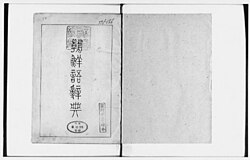Korean language
The Korean language is spoken mainly in North and South Korea. It is spoken by more than 78 million people (most are North or South Koreans).
| Korean | |
|---|---|
| 한국어, 조선말 Hangugeo, Chosŏnmal | |
 Two names for Korean, Hangugeo and Chosŏnmal, written vertically in hangul | |
| Native to | South Korea North Korea Jilin·Liaoning·Heilongjiang, China |
| Native speakers | 76 million (2007)[1] |
| Language family | Koreanic
|
| Early forms: | Old Korean
|
| Dialects | Jeju
|
| Writing system | Hangul (primary) Hanja (mixed script) Korean Braille Cyrillic (Koryo-mar) |
| Official status | |
| Official language in | |
| Regulated by | South Korea: The National Institute of the Korean Language 국립국어원/ 國立國語院 North Korea: Sahoe Kwahagwon Ŏhak Yŏnguso The Language Research Institute of Social Science 사회과학원 어학연구소/ 社會科學院 語學研究所 |
| Language codes | |
| ISO 639-1 | ko |
| ISO 639-2 | kor |
| ISO 639-3 | Variously: kor – Modern Korean okm – Middle Korean oko – Old Korean |
| Linguist List | okm Middle Korean |
| oko Old Korean | |
| Linguasphere | 45-AAA-a |
 Countries with native Korean-speaking populations. (Established immigrant communities in green) | |
Overview
In South Korea, it is called hangukmal (한국말) or hangugeo (Hangeul: 한국어, Hanja: 韓國語). In North Korea, however, it is called choseonmal (조선말) or choseoneo (조선어, 朝鮮語). They are named differently because the common names for North and South Korea are different. Additionally, Koreans usually call their language urimal (Hangeul: 우리말) or urinara mal (Hangeul: 우리나라 말), meaning "our language" or "our country's language."
Writing
Korean uses two different writing systems. One is Hangul, the main alphabet. In North Korea, only Hangeul (Known as Choseongeul in North Korea) is used by law. In South Korea, only Hangeul is used in most public areas like education, but the other system, Hanja, is still used in some newspapers and professional areas. Hanja is the system of Chinese characters that are used in Korean. It was the only way to write Korean before the creation of Hangeul in the 15th century, and it was common in novels before the 19th century.
Although King Sejong the Great led the development of Hangeul to allow literacy to spread among common people and to create a writing system that represented the language more accurately than Hanja, it was not adopted by the upper classes of Koreans. Hanja would continue to be the official writing system until the late 19th century. Although it was rejected by the elite classes, Hangeul was used often by lower classes as a way to write down Korean literature and for lower classes to communicate.
Korean Language Media
King Sejong's proclamation of the Hangul script, written in Classical Chinese
The Latin alphabet used in romanization on road signs, for foreigners in South Korea
Highway sign in Korean,Reunification Highway, Pyongyang, Korea
Highway sign in Korean and English,Gyeongbu Expressway, Daegu, Korea
References
| This language has its own Wikipedia project. See the Korean language edition. |
- ↑ Nationalencyklopedin "Världens 100 största språk 2007" The World's 100 Largest Languages in 2007








